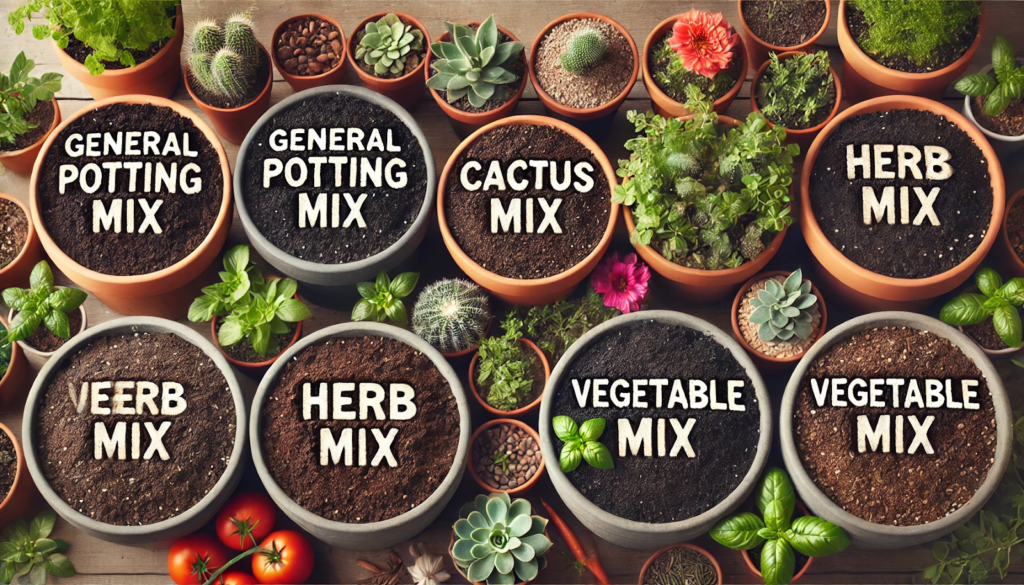One of the most critical factors for successful container gardening is the soil mix. Unlike traditional gardens where plants have access to natural earth, container plants rely solely on the medium inside their pots. That medium must provide everything they need: drainage, aeration, moisture retention, and nutrients.
In this guide, you’ll learn how to choose or make the ideal soil mix for your container plants, based on their specific needs.
Why Regular Garden Soil Isn’t Enough
Using soil from your yard in pots may seem convenient, but it’s rarely suitable for container plants. Here’s why:
- Too dense: Garden soil compacts in containers, suffocating roots.
- Poor drainage: Increases the risk of root rot and fungus.
- May contain pests or weed seeds: Can introduce unwanted problems to your containers.
Instead, container gardening thrives on specially formulated mixes that keep roots healthy and allow plants to absorb water and nutrients effectively.
Key Components of a Good Container Soil Mix
A well-balanced mix typically includes:
1. Potting Soil or Base Mix
Often made from peat moss, coir (coconut fiber), or composted bark.
- Function: Retains moisture and provides organic matter.
- Tip: Choose peat-free options when possible to reduce environmental impact.
2. Perlite or Vermiculite
These are light, volcanic materials that improve soil aeration and drainage.
- Perlite: Ideal for improving drainage and preventing compaction.
- Vermiculite: Retains more water, useful in drier conditions.
3. Compost
Adds slow-release nutrients and beneficial microbes.
- Function: Boosts soil fertility and structure.
- Tip: Use well-aged compost to avoid pathogens and weeds.
4. Worm Castings or Organic Fertilizer
Natural nutrient boosters for plant growth.
- Benefit: Enhances microbial life and supports root development.
- Use: Mix 10–20% into your potting blend.
Best Soil Mixes by Plant Type
Different plants require different types of soil depending on their natural habitat and root structure.
1. Vegetables (Tomatoes, Peppers, Lettuce, etc.)
Recommended Mix:
- 40% potting soil or composted bark
- 30% compost
- 20% perlite
- 10% worm castings or aged manure
Tip: Keep the soil light but rich in nutrients. Refresh soil between seasons to prevent nutrient depletion.
2. Herbs (Basil, Mint, Thyme, etc.)
Recommended Mix:
- 50% potting mix
- 30% compost
- 20% perlite or coarse sand
Tip: Most herbs prefer well-draining soil and don’t need heavy fertilization.
3. Succulents and Cacti
Recommended Mix:
- 40% coarse sand
- 30% potting mix
- 20% perlite or pumice
- 10% compost
Tip: These plants need excellent drainage. Avoid any mix that retains too much moisture.
4. Flowers (Annuals and Perennials)
Recommended Mix:
- 40% potting mix
- 30% compost
- 20% perlite
- 10% organic fertilizer
Tip: Flowering plants need balanced nutrition for continuous blooming.
How to Mix Your Own Soil
Step-by-Step:
- Use a large bin or wheelbarrow to mix ingredients.
- Measure each component using buckets or large scoops.
- Blend until the texture is uniform and fluffy.
- Store in a sealed container if not using immediately.
Tools Needed:
- Garden trowel or spade
- Measuring containers
- Gloves
- Bin for mixing
Store-Bought Potting Mix vs DIY
| Feature | Store-Bought | DIY Mix |
| Convenience | Very high | Requires effort |
| Customization | Limited | Fully customizable |
| Cost | Higher over time | Lower in the long run |
| Organic control | May include chemicals | 100% natural options available |
Tip: If buying pre-made soil, choose ones labeled “organic” or “for containers.”
Improving Drainage in Containers
- Always use pots with drainage holes.
- Add gravel or stones to the bottom only if the pot is large and deep (otherwise unnecessary).
- Mix perlite, bark, or sand into heavy mixes to promote better drainage.
- Elevate pots slightly to avoid water pooling at the base.
Reusing Soil: Is It Safe?
Yes, but with caution. Follow these steps:
- Remove old roots and debris.
- Mix with 30–50% fresh compost or potting mix.
- Let it rest or solarize to kill any pathogens (leave in the sun under plastic for 2–4 weeks).
Tip: Never reuse soil from diseased plants.
Seasonal Soil Care
- Spring: Refresh top layer with compost.
- Summer: Mulch to retain moisture.
- Fall: Remove spent plants and mix in compost.
- Winter: Store unused soil in a dry place to prevent mold.
Healthy Soil = Thriving Plants
No matter how beautiful your containers or how much sunlight your plants get, they won’t thrive without the right soil. Investing time in creating or choosing the proper soil mix tailored to your plants’ needs will pay off with stronger roots, faster growth, and better harvests or blooms.






